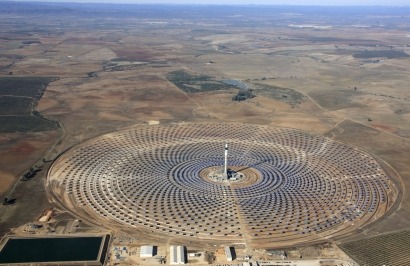
The development of new innovations in thermal storage for concentrated solar power (CSP) plants stands out in the new technologies research carried out by Sener. On the one hand, Sener develops a single-tank thermal storage system that would be an alternative to the current molten salt storage system – installed by Sener in the majority of its CSP projects – consisting of two tanks, one to store cold salts, and the other to store hot salts. On the other hand, the development of a graphite thermal storage system could offer both technical and economic advantages as opposed to current systems.
The reduction of investment costs in CSP plants is fundamental to creating a competitive industry. Moreover, as the share of renewable energy in electricity generation increases, it is becoming more and more important to have systems available that facilitate the dispatchability of these plants. A thermal storage system that is efficient, reliable, and economically competitive contributes significantly to meeting these two objectives. In this way, Sener expects to gain a significant reduction in the investment required for this type of technology thus facilitating the development of the solar thermal electricity generation market.
Thanks to the experience acquired in the design, construction and operation of the dual-tank system, Sener is working on a single-tank storage system with an insulation barrier. The objective is to design, construct, and test a reduced-scale prototype in the Valle 2 commercial plant, which Sener is constructing for Torresol Energy in Cádiz (Spain). This innovative system uses just one tank to contain salts in both their cold and hot states, separated by an insulation barrier that naturally moves up and down according to the quantity of salts in each state. The single tank has a capacity similar to that of one of the dual-system tanks, and it is permanently full. In this system, all of the pumps have short shafts. These pumps are more common in the marketplace and, therefore, they are also less expensive.
With the new system comes not only the expectation of a significant reduction in storage costs, but also of an increase in production, as thermal losses are reduced by having just one tank instead of two. Once this prototype is validated, Sener expects to start applying it on a commercial scale.
Graphite for high-temp storage
In addition, Sener is taking part in the Helsolar project, which objective is to develop and validate a solid resource (graphite) thermal storage system, suitable for average-high temperature (650ºC), adequate for a high thermal difference (~400ºC) and which offers both technical and economic advantages as opposed to current systems. This is an R&D project led by Sener, in collaboration with the company GrafTech International Ltd., and the University of California in Berkeley, in addition to being supported by other key suppliers for the project. Helsolar is funded by the US government, through the Department of Energy.
Helsolar is structured in three phases, with a foreseen duration of approximately one year for each one of them. These three phases are: basic design, detail design and demonstrator construction and testing. Currently, the Helsolar project team is working on the basic design for the storage system.
These new solutions will mean a real reduction in the investment costs for solar plants that involve a storage system. In this way, this type of efficient and dispatchable thermal power plants will improve their economic competitiveness. As has already happened in the case of dual-tank storage systems, both the single-tank project and the graphite thermal storage system are other innovations that can become a reality in the global construction of the next CSP projects.
These innovations, says Sener, confirms its position as “the technological leader in the solar thermal electric market”.
For additional information:

